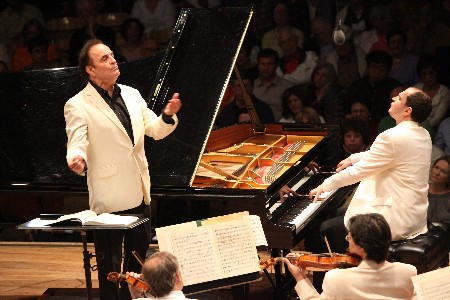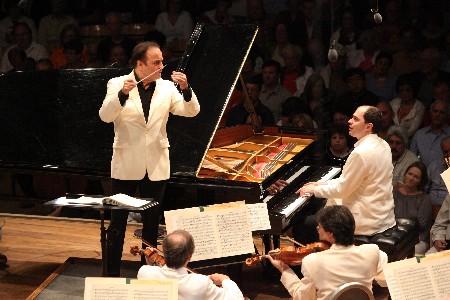Culture Vulture: Three Russian Warhorses Strut Their Stuff

Charles Dutoit conducts the BSO and pianist Kirill Gerstein at Tanglewood, July 30, 2010 (Photo: Hilary Scott)
July 30 featured a Russian warhorse program at Tanglewood: Glinka’s “Overture to Ruslan and Ludmila”; Tchaikovsky’s Piano Concerto No. 1 in B-flat minor, and Prokofiev’s Music from the ballet Romeo and Juliet.
These are familiar (some might say over-familiar) works for orchestra, but, of course, there’s a reason they’re still being programmed. Supremely accessible and dramatic symphonic pieces, they feature tunes the audience walks out humming. Snobs put them down as “easy listening,” but later composers knew their worth and mined their themes and ideas for lucrative pop music, movie, TV, Muzak, and musical comedy scores.
Why program them today? They are perennial crowd-pleasers and popular with the thousands of tourists drawn to Tanglewood as much for the beauty of the place as for the music. Also, there are always new generations of orchestral players, soloists, and audience members for whom these old chestnuts are new. The challenge is for creative artists to find new ways to bring them to life.
Veteran conductor Charles Dutoit opted for subtle rather than overblown readings of all three Russians. The masterful chief conductor of the Philadelphia Orchestra showcased all the excellent sections of the Boston Symphony Orchestra (BSO), especially the razor-sharp precision of the percussionists, the power and bombast of the brass, and the agility of the strings. The winds were especially lyrical, especially in the slow movement of the Tchaikovsky.
In the concerto, Kirill Gerstein made for an interesting piano soloist . Born in Voronezh, Russia in 1979, he underwent the typical, rigorous course of Russian piano pedagogy. But he taught himself jazz by listening to his parents’ records—he came to the U.S. at the age of 14 to study jazz at Berklee—surely one of the few Russian classical musicians to do that.

Charles Dutoit conducts the BSO and pianist Kirill Gerstein. The latter's technique is as impressive as that of Horowitz or Van Cliburn. (Photo: Hilary Scott)
Gerstein’s technique is as impressive as that of Horowitz or Van Cliburn—whom we associate with great performances of this concerto—but instead of the massive, grand interpretation of Tchaikovsky listeners have become accustomed to, Gerstein gave an intimate, musing, introverted interpretation, which I thought must have been influenced by his work in jazz. Particularly in the slow movement, Gerstein’s playing sounded more like chamber music than a concerto. Tanglewood’s cavernous shed took on the ambiance of a club. Gerstein’s flawless yet relaxed style worked well with Dutoit’s.
The wonderful BSO wind players were featured in the Prelude at Osawa Hall a couple of hours earlier in a charming program of twentieth-century music including pieces for wind ensemble by Ligeti, Berio, Janacek, and Schifrin. The ensemble included Cynthia Meyers, flute; Robert Sheena, oboe; Thomas Martin, clarinet; Richard Ranti, bassoon; Jason Snider, horn; and David Martins, bass clarinet.
The musicians were required to speak as well as play in Berio’s “Opus Number Zoo,” and some of them proved to be as engaging actors as they are musicians. Their rendition of “Tom Cats,” where the players enact witnessing a cat fight was great comedy as well as musical performance.
All in all an extremely satisfying evening at Tanglewood.
Helen Epstein’s book on the lives of classical musicians is now available on Kindle and in softcover.
Tagged: Berkshires, Boston Symphony Orchestra, BSO, Caldwell-Titcomb, Charles Dutoit, Classical Music, Culture Vulture, Kirill Gerstein, Russian

